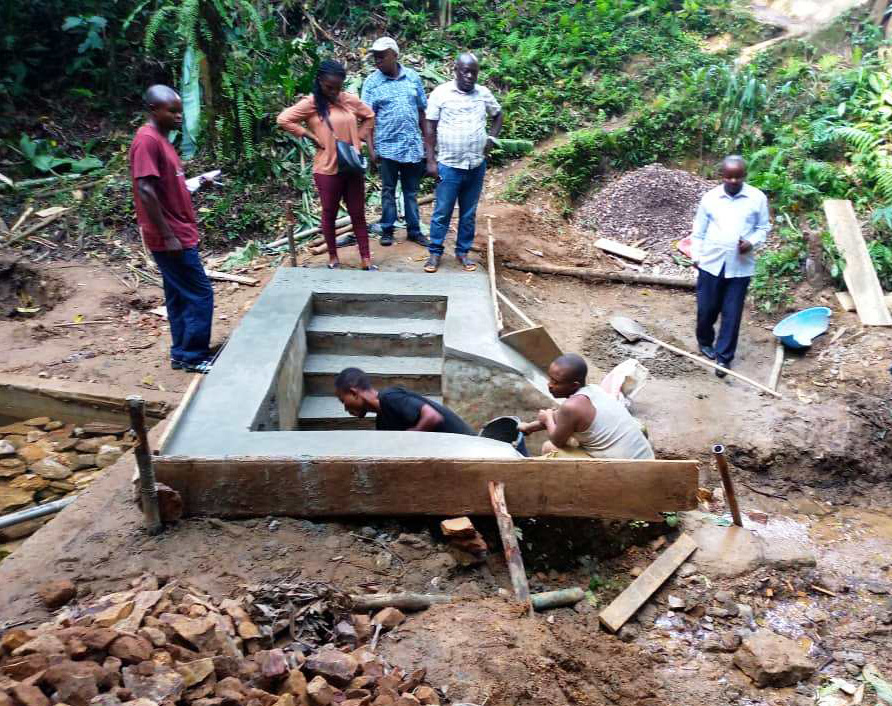Community Development Micro-Projects around Maiko National Park
Categories: Journal no. 65, Success Stories, Protective Measures, Democratic Republic of the Congo, Maiko, Grauer's Gorilla
Maiko National Park (MNP) was gazetted in 1970 by the President of what was then Zaire, Marshal Mobutu. Before the creation of the park, the area was part of the Bakumu Hunting Reserve. To create the park, the local population was relocated from the reserve. In an attempt to establish complete protection, hunting, fishing, trapping and the cutting of timber was prohibited, as was traffic through the park. However, the Government was never able to remove the Simba rebels, who had lived in the park since 1964.
Maiko National Park extends across three different provinces: the southern sector of the park is in Maniema Province, the central sector is part of Tshopo Province, and the northern sector lies in North Kivu Province.
Hunting remains a major activity around Maiko National Park, in particular the hunting of bushmeat to supply the markets of Lubutu, Bafwasende and Manguredjipa. Poaching of protected species is aimed at the capture and marketing of monkeys, baby gorillas and chimpanzees.
In 2020, the provinces of Maniema and Tshopo launched a campaign to collect hunting weapons, particularly 12-gauge shotguns, which are the main weapons produced locally. They are used predominantly for hunting, to provide income and food. The population voluntarily handed in 265 of these weapons, but the people are suffering from food shortages and a lack of income. Alternative livelihoods support was established for the people who handed over their weapons. This was initiated by ICCN (Congolese Institute for Nature Conservation) and supported by its partner Berggorilla & Regenwald Direkthilfe. These support projects include: an initiative for the rehabilitation and construction of fishponds in the southern sector of the park between Lubutu and Osso (or Oso), where people are provided with funds, material for their development, and fry (young fish); a water capture project in Obassa, Uyugu and Tingi Tingi; a mill for cassava flour in Osso in the southern sector; and a project for oil, rice and cassava mills in Manguredjipa in the northern sector, carried out by a women's association.
Project beneficiaries
| Beneficiaries/Association | No. of members | Locality | Activity | Participating villages | Quantity |
| Osso Health Centre | 8,000 | Osso | Water catchment, small-scale water distribution | Uyugu, Obassa | 4 sources |
| Bapère Development Committee/CGC-ICCN | 2,500 | Manguredjipa | oil mill rice mill | Manguredjipa | 1 1 |
| Association of Mothers for Development | 2,000 | Osso | flour mill | Osso | 1 |
| REGOMUKI | 2,200 | Lubutu | support for fish farming | Bitule | 1 |
| JAGA USIANA | 450 | Mukwanyama | support for fish farming | Mukwanyama, Batike | 3 |
| EKITA-AGANDJA | 1,500 | Obokala, Djingala | support for fish farming | Bongisia | 2 |
| AMKA MABADILIKO | 150 | Lubutu | support for fish farming | Sanzalisili | 1 |
| ULD/LEGA | 1,500 | Lubutu/EDD | support for fish farming | Mukwanyama | 1 |
| Catholic Church | 4,500 | Osso | support for fish farming | Osso | 1 |
| JAFARI Youth Association | 1,800 | Mengwe | support for fish farming | Lubutu, Osso | 1 |
| Total | 24,600 |
In addition to supporting the voluntary surrender of 12-gauge shotguns, the project also reduces poaching, sensitises the population by involving them in biodiversity conservation and community development activities, and improves relations between park managers and neighbouring communities.
In order to deliver the project, the Site Manager of Maiko National Park, together with the local chiefs, held consultations with the associations that would benefit from the project. He explained the merits of micro-projects for community development in general, the fishpond project in particular, as well as the benefits of biodiversity conservation.
These projects will support as many as 24,600 direct beneficiaries, as well as other people living in the area who benefit from selling the fish, rice, oil or cassava flour.
In the case of the fishponds, a total of 18,684 people have benefited from the project. They are the members of ten associations including one forest reserve (REGOMUKI: Mukingiti and Kingombe Gorilla Reserve), two Catholic churches in Osso, two youth associations in Obassa and five local development initiatives on the Lubutu-Osso axis. Eleven fishponds are being rehabilitated and have received fry. Monitoring of the growth of fry is under way and the harvesting of fish is expected to start in April 2023.
As for the water projects, Osso Health Centre benefited from four captured sources. The 2,000 members of the Association of Mothers for Development of Osso benefited from a cassava flour mill. In the northern sector, the 2,500 members of the Bapere/ICCN Development Committee benefited from a palm oil press and a rice husker.
Perspective for the future
The population of Osso-Obassa-Kingombe, about 10,000 people, wants Maiko National Park to provide all population centres with drinking water and thanks Berggorilla & Regenwald Direkthilfe for the capture of four water sources thus far. The need remains urgent and the further water distribution network has already been mapped.
Claude Sikubwabo Kiyengo and Jean Claude Kyungu Kasolene
These community projects were mainly funded by the Deutsche Postcode Lotterie.

